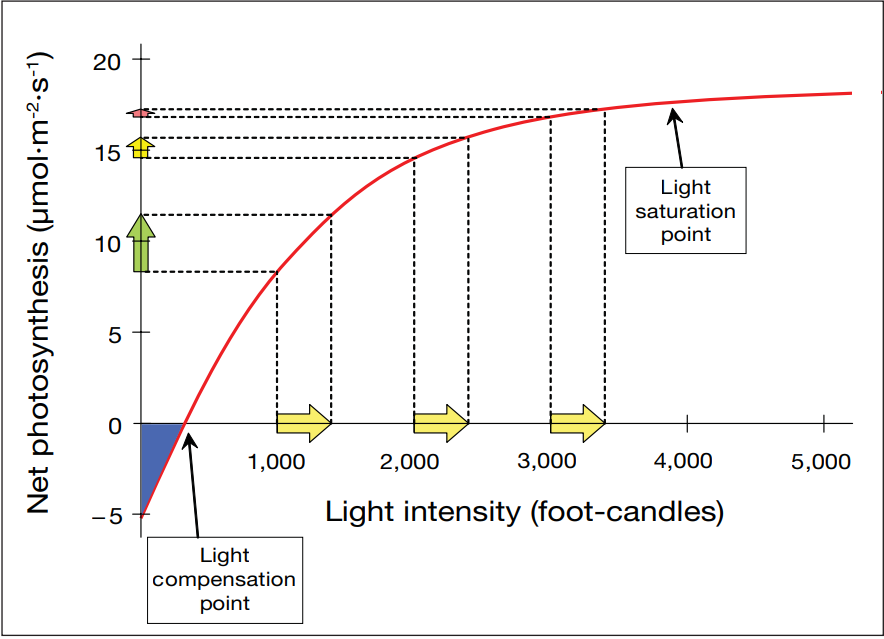
Maximizing supplemental lighting
DOWNLOADNovember 24, 2007 - E. Runkle
technically speaking By Erik Runkle
Maximizing Supplemental Lighting
It’s no secret that increasing the amount of daily light integral that greenhouse crops receive per day can result in higher-quality, healthier product. But do you know how to get the most value out of supplemental lighting?
In
the northern half of the United States and in Canada, the total quantity of light received per day, the daily light integral (DLI), can be a limiting factor in the production of many greenhouse crops from October until March. A common target minimum average DLI is 10- 12 moles per day (mol∙m-2∙d-1). There can be several negative effects on crop quality when the DLI is lower than the target minimum. For example, cuttings may be slower to root; rooting of seedling plugs can be delayed; and stock plants can have fewer branches and thinner stems.
Boosting the DLI, Not the Costs.
To increase the average DLI provided to plants, growers can only do a few things. First, the number of overhead obstructions should be minimized. For example, hanging baskets intercept light, so the DLI is reduced on crops below. Second, the glazing can be cleaned so there is no leftover whitewash or dust or grime that accumulates on the glazing material. Third, a grower can provide supplemental lighting from either high-pressure sodium or metal halide lamps
The economics of supplemental lighting in greenhouses is most favorable when provided to young plants (liners and plugs) because the cost to provide supplemental lighting is relatively small on a per-plant basis. However, even if a grower spends less than a penny to light each plug or liner, it is always wise to operate high intensity (photosynthetic) lighting efficiently. To understand how to maximize supplemental lighting, one needs to understand how light intensity influences plant photosynthesis.

Linking Supplemental Lighting and Photosynthesis
Figure 1 provides a typical example of how photosynthesis increases with light intensity. It represents the amount of carbon dioxide that is extracted for photosynthesis. In darkness and under very low light intensities (the blue region in the figure), plants actually have negative net photosynthesis, because the energy used for plant maintenance exceeds any gain of energy from photosynthesis. The light compensation point is the amount of light in which the energy used for plant maintenance is equal to the amount of energy generated from photosynthesis. This value varies among species and is typically lower for shade plants.
As light intensity increases, net photosynthesis increases but at a decreasing rate. For example, the increase in photosynthesis with a 1,000- foot-candle increase in light is greater when added to 1,000 foot-candles (1,000→2,000 foot-candles) than when added to 2,000 foot-candles (2,000→ 3,000 foot-candles). Using this photosynthesis curve, we can understand why the benefit from supplemental lighting is greatest in darkness and when ambient light levels are low. In the figure, the yellow arrows indicate the increase in photosynthesis when 400 foot-candles of supplemental lighting is added to natural light at 1,000, 2,000 or 3,000 foot-candles. The dashed lines indicate the corresponding increase in photosynthesis.
Supplemental lighting has a rather dramatic increase in photosynthesis when added to 1,000 foot-candles of light, as shown by the green arrow. Increases in photosynthesis become smaller and smaller when that same amount of supplemental light is added to higher ambient light levels, as illustrated by the yellow and red arrows. The light saturation point, which varies among species, is the point at which further increases in light do not increase photosynthesis.
Maximizing Benefi ts
What can we conclude from this rather simplistic graph? Supplemental lighting has the greatest effect on photosynthesis when lamps are turned on during darkness and when the ambient light levels are low. The benefit of supplemental lighting is low when natural light levels are moderate, and benefits are essentially nonexistent during sunny conditions. Therefore, to maximize use of supplemental lighting, operate lamps during a portion of the night, on cloudy days in the winter, and in the early morning and late afternoon on sunny winter days.
For many floriculture crops, the value of supplemental lighting is relatively small once we naturally receive at least 12-15 moles per day. Therefore, supplemental lighting is typically not used on ornamentals grown in greenhouses in northern latitudes from April through September.
Erik Runkle is associate professor and fl oriculture extension specialist in the Department of Horticulture at Michigan State University. He can be reached at runkleer@msu.edu or (517) 355-5191 ext. 1350.



 Print
Print Email
Email




